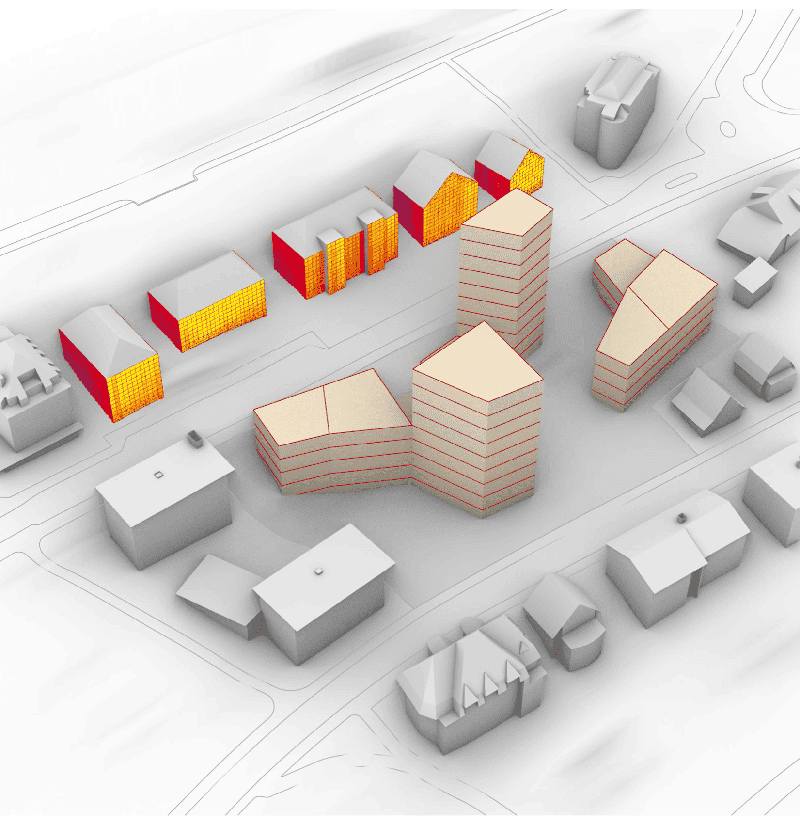
SEMIRAMIS
AI-augmented Architectural Design

Abstract
In this research, we developed a methodology for machine learning (ML)-based architectural design. Traditional architectural design involves the combination and optimization of numerous criteria and constraints. For performance-driven design, architects and engineers often use parametric models to generate, simulate, and evaluate multiple design instances, gathering performance feedback on design modifications. However, this process is typically hierarchical, limited in its ability to handle multiple concurrent objectives, and explores only a narrow portion of the design space. In contrast, we applied generative machine learning models to effectively find and explore design instances that are close to specified performance goals, bypassing the need for extensive manual tuning of input parameters. We implemented this approach in the open-source AIXD (AI eXtended Design) toolkit, which has been successfully applied to various domains beyond architecture, including the design of mechanical components, load-bearing structures, and notably, Semiramis, a vertical garden structure in Zug, Switzerland.
People
Collaborators


Luis is originally from Spain, where he completed his bachelor's studies in Electrical engineering, and the Ms.C. on signal theory and communications, both at the University of Seville. During his Ph.D. he started focusing on machine learning methods, more specifically message passing techniques for channel coding, and Bayesian methods for channel equalization. He carried it out between the University of Seville and the University Carlos III in Madrid, also spending some time at the EPFL, Switzerland, and Bell Labs, USA, where he worked on advanced techniques for optical channel coding. When he completed his Ph.D. in 2013, he moved to the Luxembourg Center on Systems Biomedicine, where he switched his interest to neuroscience, neuroimaging, life sciences, etc., and the application of machine learning techniques to these fields. During his 4 and a half years there as a Postdoc, he worked on many different problems as a data scientist, encompassing topics such as microscopy image analysis, neuroimaging, single-cell gene expression analysis, etc. He joined the SDSC in April 2018. As Lead Data Scientist, Luis coordinates projects in various domains. Several projects focus on the application of natural language processing and knowledge graphs to the study of different phenomena in social and political sciences. In the domains of architecture and engineering, Luis is responsible for projects centered on the application of novel generative methods to parametric modeling. Finally, Luis also coordinates different projects in robotics, ranging from collaborative robotic construction to deformable object manipulation.


Before joining the SDSC as a Data Scientist in April 2023, Alessandro obtained his master’s degree in Computer Science with a focus on Machine Learning from ETH Zurich. In his master’s thesis, he worked on a joint project by the SDSC and the SLF Davos in which he automated the process of avalanche danger forecasting in the Swiss Alps using state-of-the-art machine learning techniques. In his free time, Alessandro loves alpine sports like ski-touring, climbing, and mountaineering.


Fernando Perez-Cruz received a PhD. in Electrical Engineering from the Technical University of Madrid. He is Titular Professor in the Computer Science Department at ETH Zurich and Head of Machine Learning Research and AI at Spiden. He has been a member of the technical staff at Bell Labs and a Machine Learning Research Scientist at Amazon. Fernando has been a visiting professor at Princeton University under a Marie Curie Fellowship and an associate professor at University Carlos III in Madrid. He held positions at the Gatsby Unit (London), Max Planck Institute for Biological Cybernetics (Tuebingen), and BioWulf Technologies (New York). Fernando Perez-Cruz has served as Chief Data Scientist at the SDSC from 2018 to 2023, and Deputy Executive Director of the SDSC from 2022 to 2023
PI | Partners:
ETH Zurich, Gramazio Kohler Research:
- Prof. Matthias Kohler
- Prof. Dr. Arno Schlüter
- Dr. Aleksandra Anna Apolinarska
- Dr. Romana Rust
description
Motivation
Design in Architecture, Engineering and Construction (AEC) can be described as an ill-defined (“wicked”) problem with many parameters, multiple constraints and contradicting objectives. Traditionally, only a very small number of possible solutions is considered, created based on human best-guess or they are limited to blanket solutions. Parametric design tools such as Grasshopper allow the automated generation of large numbers of potential solutions, and the integration of performance measures. Still, parametric modelling (Figure 1) only allows to carry out forward design, which still restrict the exploration capabilities of the designer, and a broader exploration of the solution space.

Proposed Approach / Solution
We have implemented a methodology for inverse design that leverages the traditional parametric model. By using design instances generated using the parametric model, we can train a ML model (see Figure 2) to carry out two tasks. First, accelerate forward modelling by learning a surrogate model of the mapping from design parameters to performance measures. Second, perform inverse design, i.e., given a set of desired performance measures, the trained model will suggest designs satisfying those. Specifically, we have leveraged autoencoders, as in this architecture we can use the trained encoder as surrogate model, and the decoder as generator. We have implemented this methodology in an open-source toolbox called AIXD (AI eXtended Design).

Impact
This methodology unleashes novel design possibilities by offering designers insights into solutions they might not have otherwise imagined. It helps mitigate unconscious bias and enables the combination of human synthetic thinking with the analytical power of computation. Furthermore, through the AIXD toolbox intend to bridge the gap that exists between designers and ML methodologies. We address this by abstracting away the complexity of deploying use-case specific ML models, and by providing tools for design exploration, performance-driven generation, etc. We have applied this approach in several use cases, such as Semiramis (see Figure 3), a vertical garden structure built in Zug, Switzerland. We believe this design paradigm, supported by ML tools, can enhance human intuition about design problems and enable a more exhaustive and efficient exploration of the solution space.

Presentation
Gallery
Annexe
Additional resources
Bibliography
- Nauata, N., Chang, K. H., Cheng, C. Y., Mori, G., & Furukawa, Y. (2020). House-gan: Relational generative adversarial networks for graph-constrained house layout generation. In Computer Vision–ECCV 2020: 16th European Conference, Glasgow, UK, August 23–28, 2020, Proceedings, Part I 16 (pp. 162-177). Springer International Publishing. https://doi.org/10.1007/978-3-030-58452-8_10
- Oh, S., Jung, Y., Kim, S., Lee, I., & Kang, N. (2019). Deep generative design: Integration of topology optimization and generative models. Journal of Mechanical Design, 141(11), 111405. https://doi.org/10.1115/1.4044229
- Brown, N. C., & Mueller, C. T. (2019). Design variable analysis and generation for performance-based parametric modeling in architecture. International Journal of Architectural Computing, 17(1), 36-52. https://doi.org/10.1177/147807711879949
- Sohn, K., Lee, H., & Yan, X. (2015). Learning structured output representation using deep conditional generative models. Advances in neural information processing systems, 28. Learning Structured Output Representation using Deep Conditional Generative Models
Publications
Related Pages
Software
Press and media
- Show case video
- Various news articles: NZZ, designboom, e-architect
- ETH press release
Blog posts
More projects
SFOE Energy Dashboard
Enhancing resource efficiency
Sustainable ingredients
News
Latest news


PAIRED-HYDRO | Increasing the Lifespan of Hydropower Turbines with Machine Learning
PAIRED-HYDRO | Increasing the Lifespan of Hydropower Turbines with Machine Learning


First National Calls: 50 selected projects to start in 2025
First National Calls: 50 selected projects to start in 2025


AIXD | Generative AI toolbox for architects and engineers
AIXD | Generative AI toolbox for architects and engineers
Contact us
Let’s talk Data Science
Do you need our services or expertise?
Contact us for your next Data Science project!




